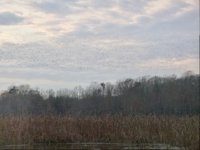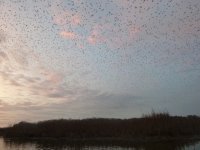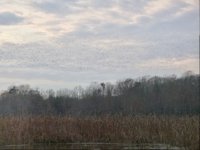Recently saw the most massive flock of birds I've ever seen. It was near dusk on Mattaponi Creek, a trib of the Patuxent River, and a band of birds started moving across the sky, north to south. It looked like a ribbon, undulating in the sky as it moved along. At first I thought it was a murmuration, but it just kept on coming. I sat in my canoe watching for a good 5 minutes, thinking I should take a photo, but by the time I get the camera out, it'll be over. Wrong. First photo was time stamped 4:53. The band of birds got larger and larger, eventually covering the whole sky and extending to the horizon, as in the second photo, taken at 4:58. I'd say, in total, it took this flock 12-15 minutes to fly over. Can't imagine how many birds there were.
I'm not a birder, so can't say if this is unusual, but I certainly never saw anything like it. A question: how does such a large flock survive? I'm guessing they have to break up to feed, because a flock with thousands upon thousands of birds would consume all the food in any area where they land.

I'm not a birder, so can't say if this is unusual, but I certainly never saw anything like it. A question: how does such a large flock survive? I'm guessing they have to break up to feed, because a flock with thousands upon thousands of birds would consume all the food in any area where they land.




